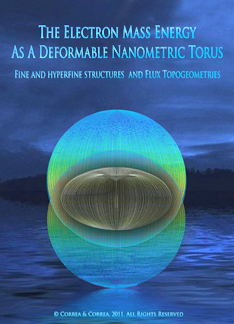![Akronos logo]](/images/akronos_wheel.jpg)
|
Akronos Publishing Concord, ON, Canada www.aetherometry.com |
![Akronos logo]](/images/akronos_wheel.jpg)
|
Akronos Publishing Concord, ON, Canada www.aetherometry.com |

The electron mass-energy flux as a deformable nanometric torus
- fine and hyperfine structures and flux topogeometries
by Correa, Paulo N. & Correa, Alexandra N.
Published in July 2011. 86 pages.
Aetherometric Theory of Synchronicity, Vol. 3
Monograph AS3-III.4
Price: US $80 ($35 ISFA)
|
ABSTRACT
We examine the physical functions behind classical theory, Bohr’s neo-classical approach, and the most recent quark model of the electron, and propose an alternative model that finds the electron rest energy to have (1) fine and hyperfine structures that conserve mass, force, linear and angular momenta; (2) volumetric flux geometry and (3) a singular deformable topology that varies with states of motion. We determine the ring current (e τk-1) = 1.03074229*10-3 C sec-1, the wattage and rate of time-flow of the electron mass-energy flux and its natural synchronization with the Time-manifold of the Aether lattice. We differentiate the topogeometric models of the (globular) photon and the (toroidal) electron brought out by aetherometric analysis, and suggest distinct torus geometries for the electroinertial and photoinertial flux configurations. We find that so-called “states of spin” present a cylindrical hypercoiled conformation of the photoinertial configuration, and that inertial acceleration may involve coniform hypercoiled transitions of the spin-state electron mass-energy flux, that bridge between the distinct flux configurations. The anomalous magnetic moment (modified by the Landé factor g) is derived as a property of the hypercoiled conformations of the mass-energy flux in the photoinertial configuration. The ‘spin state’ value of electric charge as a linear momentum is found to be (g pe) = λe(g Wk) = λe(λh2 υk) = λe Wk2 = 13.98664191 m2 sec-1 as opposed to the value of electric charge in the electroinertial configuration which is pe = λe Wk = λe(λh υk) = λe Wk = 13.97017654 m2 sec-1 We contrast, feature by feature, the aetherometric analysis of the electron mass-energy flux with the most recent model proposed by quark theory (QED/QCD). In fact, no real fine or hyperfine structures are brought out by the latter, and we formally show that the determination of the electron mass sought, but missed, by QED is simply me = h υδe/c2 =∫= h /λce c = (λce pe η/c2) υδe= (λx pe/c2) υδe= λe |